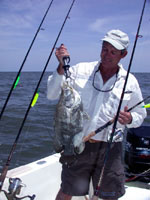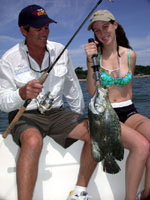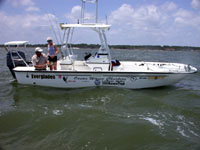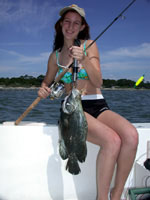
|
Features
|
|
|
|
Books
|
|
|
|
Fun & Games
|
|
|
|
Contact Us
|
|
|
John's Journal... Entry 145, Day 2
TRIPLETAIL OFF GEORGIA'S COAST
Weird Ways to Catch Tripletail
 EDITOR'S
NOTE: If you've never experienced tripletail fishing, you've missed
one of the finest sports in all of salt-water fishing. The tripletail
resembles a giant bream and got its name because its anal and pectoral
fins sweep back towards its tail, giving the appearance of the fish having
three tails. This week we'll take you with us on a tripletail-fishing
trip to Brunswick, Georgia, with Captain Greg Hildreth. We'll also bring
you up-to-date on some of the latest research on tripletail conducted
by Jim Franks and Reed Hendon, fisheries research biologists at the University
of Southern Mississippi's College of Marine Science Center for Fisheries
Research and Development. Tripletail live in the Atlantic Ocean, the Indian
Ocean, the western Pacific Ocean and the Gulf of Mexico. But anglers nor
scientists know very much about this fun-to-catch and delicious-to-eat
fish.
EDITOR'S
NOTE: If you've never experienced tripletail fishing, you've missed
one of the finest sports in all of salt-water fishing. The tripletail
resembles a giant bream and got its name because its anal and pectoral
fins sweep back towards its tail, giving the appearance of the fish having
three tails. This week we'll take you with us on a tripletail-fishing
trip to Brunswick, Georgia, with Captain Greg Hildreth. We'll also bring
you up-to-date on some of the latest research on tripletail conducted
by Jim Franks and Reed Hendon, fisheries research biologists at the University
of Southern Mississippi's College of Marine Science Center for Fisheries
Research and Development. Tripletail live in the Atlantic Ocean, the Indian
Ocean, the western Pacific Ocean and the Gulf of Mexico. But anglers nor
scientists know very much about this fun-to-catch and delicious-to-eat
fish.
 Question:
Other than live shrimp, on what are you catching tripletail?
Question:
Other than live shrimp, on what are you catching tripletail?
Answer: When I first started catching tripletail, I noticed that
they would attack the cork -- many times even after they had eaten the
live shrimp. And sometimes a tripletail would attack the cork instead
of the live shrimp. So I decided to try and fish for them with the same
surface lures that I used for bass fishing. To date, I've caught tripletails
on the Zara Puppy Spook, which is a small Zara Spook lure that walks from
side to side. The tripletail will follow the Puppy Spook and then attack
it. I've also taken tripletails regularly on the Rebel Pop-R in the fire-tiger
color. The tripletails seem to be attracted to bright colors. I'll cast
the Pop-R past the fish, swim the lure up and right in front of their
faces and begin to twitch the lure, which the tripletail will attack.
Another lure I've been extremely successful with is the DOA Shrimp, which
I'll rig under a popping cork. If you're making a long cast to a tripletail
and throw your live shrimp off, you can quickly and easily pick up the
rod and cast the DOA Shrimp to the tripletail, which will take the DOA
Shrimp. If while we're fishing for tripletail our live shrimp die or we
have a difficult time finding live shrimp for bait, the DOA Shrimp is
a great substitute. Also I have anglers who prefer to fish with artificial
baits instead of live baits so they can fish with those artificial baits.
Question: Greg, why did you start fishing these
artificial lures?
Answer: I knew I could catch tripletails on live shrimp, and I
just wanted to see what other kinds of different baits I could use to
catch them. These artificial lures are conditioned baits. With lures like
the Puppy Spook and the Pop-R, you have to fish these baits when you're
not fishing in a heavy ocean and a strong west wind. When you're fishing
surface lures, you want to be able to make long casts and have plenty
of time for the fish to see and watch the bait work before it attacks.
In a heavy ocean or a strong wind, I want to cast right to the tripletail
and get the fish to eat the bait as soon as it sees the lure, before the
boat can blow in on top of the fish and spook it.
 Question:
Greg, how do you fish the DOA Shrimp?
Question:
Greg, how do you fish the DOA Shrimp?
Answer: I fish a DOA Shrimp underneath the Equalizer cork, just
as though it's a live shrimp. I take the weight that's in the DOA Shrimp
out of the lure. This way the bait doesn't sink and tends to suspend more.
We asked Reed Hendon to give us more information about the research that he and Jim Franks have been performing for the University of Southern Mississippi's College of Marine Science for four years on tripletail in the Gulf of Mexico and specifically what the State of Florida is doing to manage tripletail. Hendon: Currently, the State of Florida has a 15-inch minimum-size limit on tripletail and a two-fish per-day bag limit. We're seeing more states beginning to manage tripletail and beginning to sell the fish.
 Question:
Reed, what have you learned about the tripletail?
Question:
Reed, what have you learned about the tripletail?
Hendon: We haven't learned anything about the migration of tripletail.
We believe they migrate like the cobia do, because they seem to hang out
in the same general area and appear about the same time. I think that
if we're going to have a problem studying tripletail, it will be in tagging
and recapturing tagged fish. Tripletails are found primarily along weed
lines and generally tend to hold in the same areas for a period of time.
Therefore, if someone tags a tripletail one day, someone else may recapture
it a couple of days later. Right now we have very-few tagged tripletail
out in the water. We have just sent out tagging kits to anglers to get
them to start tagging fish for us. Our study has a real need for people
to tag tripletail. So, if any of your readers are interested in tagging
the fish, just have them e-mail or call us for a tagging kit.
* To plan a trip to the Georgia coast to catch
tripletail this year, contact Captain Greg Hildreth at (912) 261-1763.
You also can visit www.georgiacharterfishing.com
to learn more.
* I recommend you stay at the really nice Beachview Club with its
spacious rooms. The majestic water oaks surrounding the hotel help to
shade the pool and the rooms. Too, you can look out your window and see
where you'll be fishing the next morning. You can write the Beachview
Club at 721 North Beachview Drive, Jekyll Island, Georgia 31527, phone
(912) 635-2256, fax (912) 635-3770; you also can e-mail this hotel at
beachview@technonet.com
* To learn what all you can do on Jekyll Island, contact Maxine
Smith at the Jekyll Island Authority, phone (912) 635-2236 or (912) 635-4076,
fax (912) 635-4004 or e-mail her at msmith@jekyllisland.com
* For more information about the type of
sunglasses you need to wear to see the tripletail, contact Don Dingman
of Ocean Waves at (904) 509-0026 cell phone, (904) 276-1164 home phone
or by e-mail at snole1@fbn.com
* To tag tripletail and help fisheries scientists with their research,
contact Jim Franks or Reed Hendon at the University of Southern Mississippi
College of Marine Science Center by calling (228) 872-4202 or e-mailing
jim.franks@usm.edu or reed.hendon@usm.edu
TOMORROW: WHAT YOU'RE GOING TO CATCH
Check back each day this week for more TRIPLETAIL OFF GEORGIA'S COAST ...
Day 1 - Fun Catching Tripletail
and the Equipment You Need
Day 2 - Weird Ways to Catch Tripletail
Day 3 - What You're Going To Catch
Day 4 - The Secret of Blackbeard's Tripletail
Day 5 - When Do the Tripletail Start Invading
the Channel Markers?